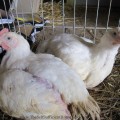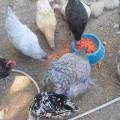| Online: | |
| Visits: | |
| Stories: |

| Story Views | |
| Now: | |
| Last Hour: | |
| Last 24 Hours: | |
| Total: | |
Choosing Chickens: How to Select Chickens for the Small Farm or Homestead
Share and Enjoy • Facebook • Twitter • Pinterest • LinkedIn • Add to favorites • Google • Google Plus • Delicious Share on Facebook
Did you know there are more than 200 breeds of chickens? Why do you care? Besides color, plumage pattern, style of comb and wattles — somewhat cosmetic considerations — chicken breeds differ on everything from personality, to broodiness (tendency to sit on eggs to hatch them), to winter hardiness and even egg color! Plus, some farmers raise them to show, or breed rare varieties to keep them going, or just because they like that particular breed.
Size
Chicken breeds are divided into one of two categories of size: standard or large, and bantam. In fact, many breeds are available in both sizes. Large breeds are, simply, larger than bantam breeds, and produce more meat and eggs. Bantams may be one-quarter to one-fifth the size of a large-breed chicken. Their eggs are smaller, and bantams can continue to fly throughout their lifetime. Bantams tend to be a little more intense in temperament than large breeds as well.
Some hobby farmers enjoy raising bantam chickens, breeding them, and showing them. Others do the same with large breed chickens. But farmers who are raising chickens for eggs and/or meat will likely choose large breed chickens for their greater efficiency in producing them. Some like to keep a few banties mixed in with the large breed chickens just for variety and as more of a “pet” chicken.
Heavy Breeds
If you live in a region with cold winters, whether a chicken breed is classified as “heavy” might matter to you. Heavy breeds have thicker bodies and denser feathers, and are happier in the cold than non-heavy breeds. They’re more likely to continue laying eggs through the winter as well.
Hardiness
Hardiness is not just a description of how well a chicken is suited to a cold winter. It refers to the breed’s ability to sustain itself through tougher times, any genetic weaknesses, and its tendency to forage versus eating feed, often called “thriftiness.” Some of the older, less heavily factory farmed breeds like the heritage or heirloom breeds still retain many of the qualities that chickens needed when they were living in backyards all across the country. In contrast, production breeds have sometimes lost the ability to brood over a clutch of eggs, or forage for bugs, weeds, and small rodents in the fields and woods. Click to read the full article on The Garden Prepper
Share and Enjoy • Facebook • Twitter • Pinterest • LinkedIn • Add to favorites • Google • Google Plus • Delicious Share on Facebook
Source:






 Raising Meat Chickens [VIDEO]
Raising Meat Chickens [VIDEO] How to Get More Eggs from Your Laying Hens
How to Get More Eggs from Your Laying Hens Resolve to Waste Less (With Chickens)
Resolve to Waste Less (With Chickens)